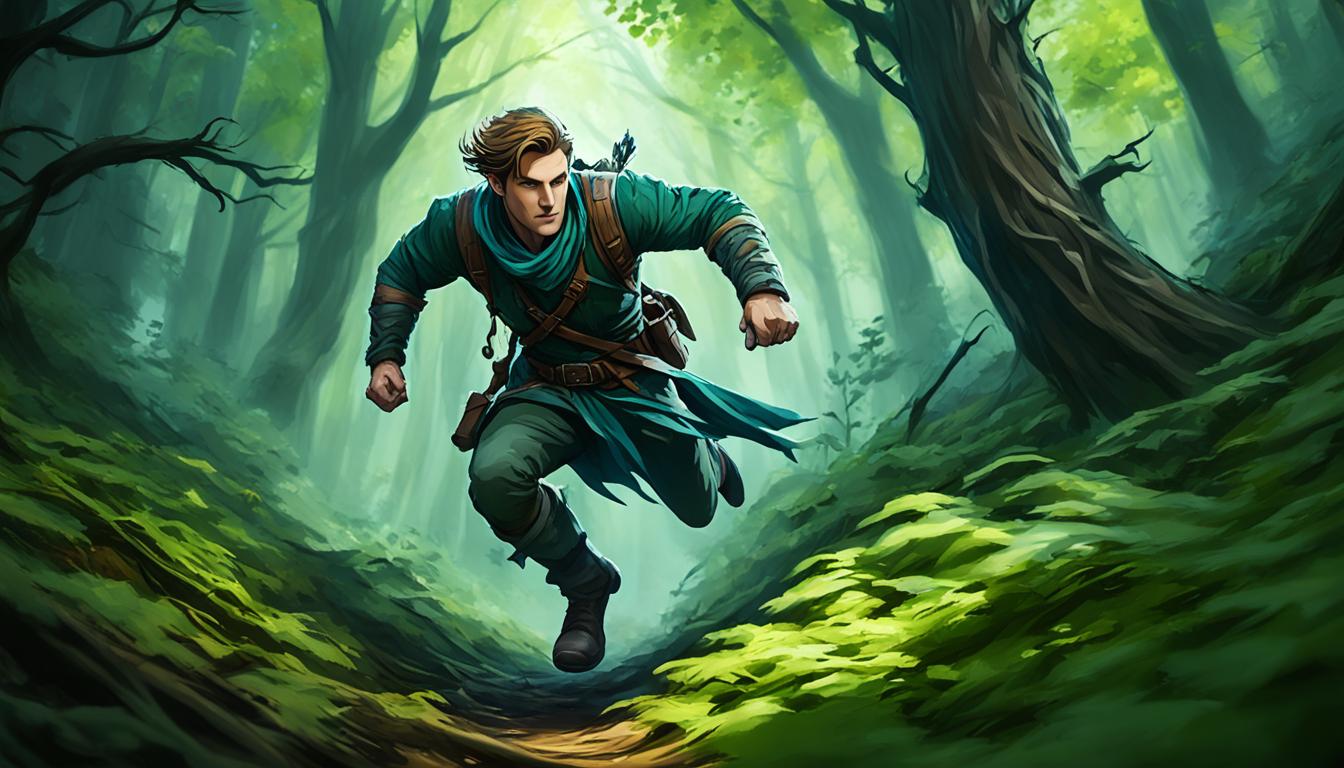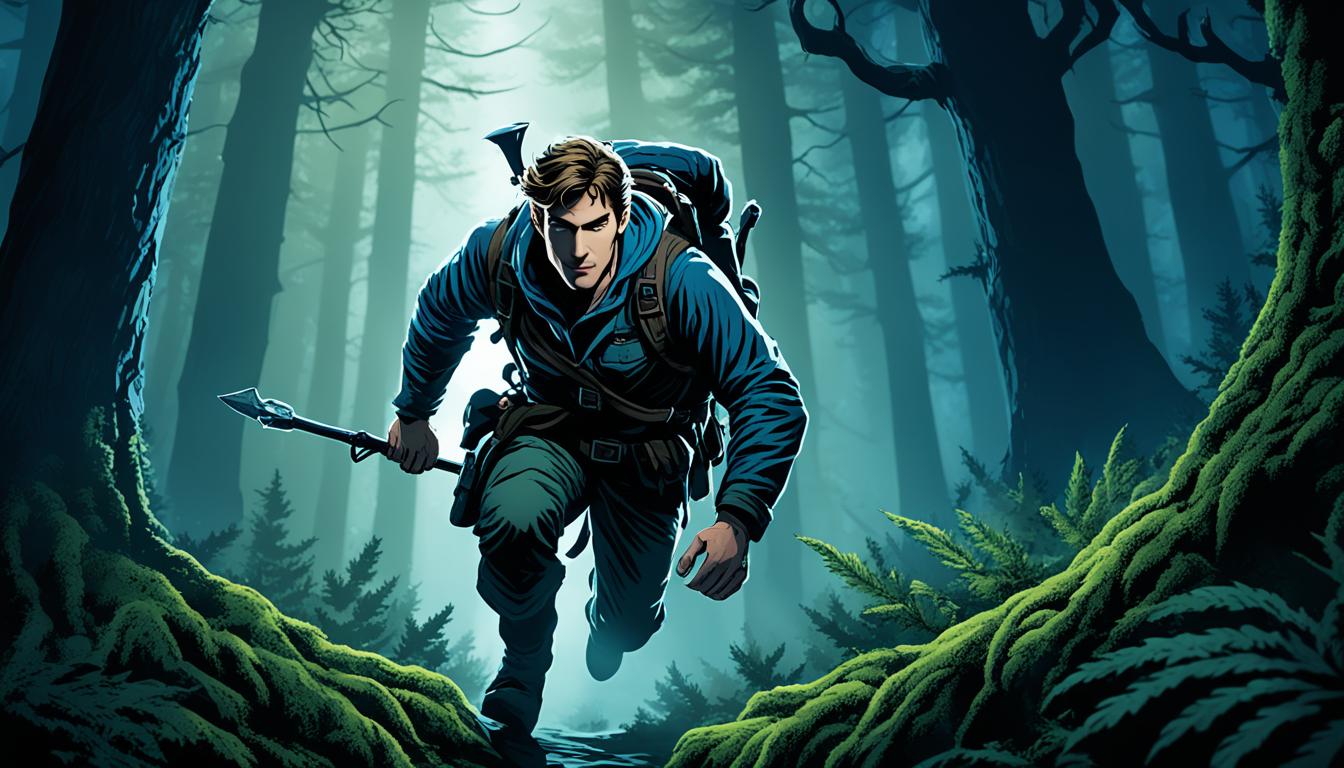Master Stealth With Pass Without Trace 5e!
Are you tired of constantly being spotted by enemies? Do you want to move through the shadows undetected? Look no further than Pass Without Trace, a powerful spell in D&D 5th Edition that can turn you into a true master of stealth.

Pass Without Trace is a second-level spell that creates a veil of shadows and silence around you and your companions, masking your presence and making you nearly impossible to detect. By casting this spell, you and your chosen allies gain a +10 bonus to Dexterity (Stealth) checks, allowing you to move silently and remain unseen.
But that’s not all! Pass Without Trace also provides protection against being tracked. Your movements leave no tracks or traces, and you can only be detected through magical means. This spell is a must-have for any character who values stealth and wants to stay one step ahead of their foes.
Key Takeaways:
- Pass Without Trace is a second-level spell in D&D 5th Edition that grants a +10 bonus to Dexterity (Stealth) checks.
- It creates a veil of shadows and silence, making you and your allies nearly undetectable.
- The spell also prevents tracking, leaving no traces or tracks of your passage.
- Pass Without Trace is particularly beneficial for times when you need the entire party to pass their stealth checks.
What is Pass Without Trace 5e?
Pass Without Trace is an abjuration spell available to Druids and Rangers. It has a casting time of 1 action and a duration of up to 1 hour. The spell requires verbal, somatic, and material components, specifically ashes from a burned leaf of mistletoe and a sprig of spruce. When cast, a veil of shadows and silence emanates from the caster, providing a +10 bonus to Dexterity (Stealth) checks for all chosen creatures within 30 feet. These creatures also cannot be tracked through normal means and leave no traces of their presence.

How to Use Pass Without Trace Effectively
One of the key advantages of Pass Without Trace is its ability to provide a +10 bonus to Dexterity (Stealth) checks for all chosen creatures within 30 feet. Pass Without Trace is not invisibility, iy boosts your stealth but still relies on you sticking to the shadows and being sneaky. Your DM is not going to let you walk into the middle of a brightly lit room filled with enemies unseen.
When stealth is an option however, the bonus can make a significant difference. Additionally, Pass Without Trace ensures that you and your companions cannot be tracked by normal means and leave no traces of your presence behind. Pass Without Trace has a duration of up to 1 hour (with concentration), allowing you and your allies to move together silently and undetected for an extended period. This makes it particularly useful for group-based stealth operations or when exploring dangerous territories as a team.
To help you visualize the effectiveness of Pass Without Trace, here’s a breakdown of situations where this spell can be utilized:
-
Exploration: Pass Without Trace proves invaluable when exploring hidden caves, ancient ruins, or mysterious forests. It grants you and your party the ability to traverse dangerous environments without alerting lurking creatures or setting off traps.
-
Espionage: When undertaking espionage missions, Pass Without Trace allows you to move silently and undetected through enemy territories. Whether you’re gathering crucial information or infiltrating the headquarters of powerful adversaries, this spell can be the key to success.
-
Surprise Attacks: Pass Without Trace sets the stage for surprise attacks by ensuring your approach remains silent and hidden. Ambush unsuspecting enemies, gain the upper hand in combat, and strike with precision before they even know what hit them.

Official D&D 5e Stealth Rules
In Dungeons & Dragons 5th Edition, the game provides a set of official rules for the intricate mechanics of stealth. These rules encompass various aspects such as movement, vision, group checks, and passive ability checks. As an avid player or Dungeon Master (DM), understanding these rules is crucial to fully harness the potential of spells like Pass Without Trace and other stealth mechanics in the game.
Movement Rules
When it comes to movement during stealth, there are certain guidelines to keep in mind. Characters typically move at a slower pace to minimize noise and visibility. The official rules suggest using the variant rule “Variant: Encumbrance” in the Player’s Handbook to further enhance realism in tracking a character’s movement in relation to their carrying capacity. Additionally, the Dungeon Master’s Guide provides advice on how to handle sounds and noise levels in different environments, which can impact the success of stealthy movement.
Vision Rules
Vision plays a significant role in stealth encounters. Understanding the mechanics of vision and how it interacts with stealth is important for both players and DMs. The Player’s Handbook describes different levels of light and how they affect visibility, including dim light, darkness, and the limitations of darkvision. These rules determine the chances of successfully remaining unheard and unseen in various lighting conditions. Combined with the use of appropriate spells, such as Pass Without Trace, characters can leverage their environment to gain tactical advantages.
Group Checks
In certain situations, multiple characters may need to make stealth checks together as a group. The official rules provide guidelines for group checks, allowing the group to pool their collective abilities to achieve a group Stealth check result. This encourages teamwork and coordination among the party members, fostering a sense of unity and facilitating the success of stealthy endeavors.
Passive Ability Checks
Passive ability checks are a way to incorporate characters’ abilities into passive checks made by the DM. In the case of stealth, passive ability checks can be useful for determining if characters notice hidden enemies or evade detection from NPCs. Understanding how passive ability checks work in relation to stealth helps DMs create balanced and immersive gameplay experiences.
By familiarizing yourself with the official D&D 5e stealth rules, you can effectively employ strategies such as casting Pass Without Trace to manipulate the game’s mechanics and gain an advantage in stealth encounters. It’s essential to consult the Player’s Handbook, Dungeon Master’s Guide, and other official rulebooks for detailed explanations and examples that will greatly enhance your D&D experience.

Stealth Encounter = Exploration
When it comes to stealth encounters in D&D, it’s essential to approach them as a form of exploration rather than just modified combat encounters. In these encounters, the focus shifts from brute force to the art of navigating the environment without being detected. It’s all about relying on more than just combat skills to outsmart and outmaneuver opponents.
Stealth encounters offer players a unique opportunity to delve into their surroundings, solving puzzles, overcoming natural barriers, and employing cunning strategies to achieve their objectives. It’s not just about avoiding a fight; it’s about utilizing stealth and subterfuge to succeed.
By treating stealth encounters as a form of exploration, players are encouraged to think creatively and strategically. They must carefully observe their surroundings, search for hidden paths or clues, and make intelligent decisions to progress. This adds a layer of excitement and depth to the gameplay, making each encounter a thrilling adventure.
The Benefits of Stealth Encounters
Incorporating exploration elements into stealth encounters can bring numerous benefits to the gameplay and the story. Here are a few advantages of treating stealth encounters as exploration:
- Enhanced immersion: By focusing on exploration, players become more immersed in the game world as they carefully observe and interact with their surroundings.
- Intellectual engagement: Stealth encounters that require problem-solving and strategic thinking keep players intellectually engaged, constantly analyzing and devising plans to overcome challenges.
- Rewards creativity: Stealth encounters provide opportunities for players to showcase their creativity and ingenuity, as they find unique ways to accomplish their goals while remaining undetected.
- Heightened tension: The stealth aspect adds a layer of tension and excitement to the gameplay, as players must carefully navigate dangerous territory while avoiding detection.
Treating stealth encounters as exploration elevates the D&D experience, offering players a dynamic and immersive gameplay style that goes beyond traditional combat encounters. It rewards critical thinking, creativity, and careful decision-making, fostering a sense of accomplishment and satisfaction when successfully overcoming challenges with finesse and stealth.
The Problems with 5e Stealth
While Pass Without Trace can enhance stealth in D&D, there are inherent challenges within the 5th Edition stealth mechanics. The vision rules in 5e can be vague and confusing, making it difficult to determine how invisibility and other factors affect stealth. Additionally, passive ability checks and the reliance on sight in perception checks can create disparities in stealth outcomes.
The Vision Dilemma
The 5e vision rules often lack clarity, leaving players and DMs wondering how various factors impact stealth. For example, when a character becomes invisible, the rules do not explicitly state how this affects their stealthiness. Is the character completely undetectable, or does it provide advantage on Dexterity (Stealth) checks? The lack of definitive answers can lead to inconsistent rulings at the gaming table.
The Passive Ability Conundrum
Passive ability checks are an integral part of D&D, including stealth encounters. However, the reliance on passive perception checks based on sight poses challenges for stealth mechanics. A character’s successful stealth check can be easily negated by a high passive perception score, even if there are no visual cues. This discrepancy can lead to frustrating and unrealistic outcomes, reducing the effectiveness of stealth-oriented characters and strategies.
Addressing the Disparities
Despite the challenges, there are ways to address the disparities in 5e stealth. As a player or Dungeon Master, it’s important to establish clear house rules or guidelines to fill in the gaps left by the vision rules. This can include defining the effects of invisibility on stealth, clarifying the circumstances that trigger passive perception checks, and considering alternative checks such as passive Investigation or Insight to represent different methods of perception and detection.
By addressing these issues and open discussions about the interpretation of the rules, players and DMs can navigate the complexities of stealth mechanics in D&D 5e and ensure a more satisfying and balanced gameplay experience.

Solutions for Stealth in D&D 5e
As a Dungeon Master (DM), you have the power to introduce homebrew solutions to address the challenges of stealth in D&D 5th Edition. These solutions can add new mechanics and enhance the overall gameplay experience for your players. Two possible homebrew solutions to consider are the passive ability mechanic and the suspicion mechanic.
The Passive Ability Mechanic
The passive ability mechanic allows you to set a DC (Difficulty Class) for the observers’ Perception checks. Instead of rolling a d20 for every Perception check, you can use a passive Perception score for each observer. Players trying to remain hidden must beat the observers’ passive Perception score with their Stealth check.
Implementing the passive ability mechanic streamlines gameplay and reduces the number of dice rolls, enabling a smoother and more immersive experience during stealth encounters. This solution ensures that players’ stealth efforts are consistently met with appropriate challenges.
The Suspicion Mechanic
The suspicion mechanic adds an element of tension and unpredictability to stealth encounters. Whenever players engage in suspicious activities, such as stealing an important artifact or speaking in hushed tones, you can track their suspicion levels.
Using a scale from 0 to 10, with 0 representing no suspicion and 10 indicating high suspicion, the DM can assign suspicion points based on player actions. As suspicion increases, NPCs become more alert and vigilant, making it harder for the players to remain undetected. This mechanic adds an extra layer of strategy and consequences to stealth gameplay, heightening the sense of danger and excitement.
Here’s an example of how the suspicion mechanic table can be structured:
| Suspicion Level | Description |
|---|---|
| 0-2 | Unsuspicious: No additional precautions or scrutiny from NPCs. |
| 3-5 | Cautious: NPCs become more aware of their surroundings and may investigate suspicious activities. |
| 6-8 | Suspicious: NPCs actively search for potential intruders or hidden information, increasing the difficulty of Stealth checks. |
| 9-10 | Alert: NPCs are on high alert, using all available resources to identify and neutralize threats. |
By incorporating these solutions, you can create a more dynamic and engaging stealth experience in your D&D 5e campaigns. The passive ability mechanic encourages players to strategize their approach, while the suspicion mechanic adds a sense of urgency and risk to their activities. Experiment with these homebrew solutions and tailor them to suit your campaign’s needs, making stealth encounters memorable and rewarding.
General Tips for DMs Running Stealth Encounters
Running stealth encounters as a Dungeon Master (DM) can be an exciting way to challenge your players and add depth to your adventures. To create memorable stealth encounters, consider implementing the following tips and rules:
Incorporate Takedown Rules
One way to make stealth encounters more dynamic and rewarding is by incorporating takedown rules. Allow players who successfully perform a stealth attack to have the option to instantly incapacitate or disable their target. This adds a sense of skill and strategy to stealth combat and rewards players for their sneaky tactics.
Reward Player Preparation and Creativity
Encourage players to think outside the box and reward their preparation and creativity when approaching stealth encounters. If a player comes up with a clever plan or utilizes their character’s unique abilities to overcome obstacles or gain an advantage, provide them with bonus rewards or advantages during the encounter. This incentivizes player engagement and fosters a sense of agency in the game.
Use Multiple Skills for Stealth
Stealth encounters can involve more than just Dexterity (Stealth) checks. Encourage players to use a variety of skills to remain unseen, such as Perception, Deception, and even Acrobatics or Arcana for magical stealth. By allowing players to employ different skills, you create a more diverse and immersive stealth experience that reflects the various methods characters can employ in remaining undetected.
Implementing these tips and rules can help you create engaging and challenging stealth encounters that will keep your players on their toes. Remember to foster a sense of collaboration and communication between you and your players, and always be open to creative solutions and unexpected outcomes.
Improving Stealth in D&D 5e
When it comes to the art of stealth in D&D 5e, players and DMs can collaborate to enhance its effectiveness. By understanding the rules and mechanics of stealth, strategically utilizing spells like Pass Without Trace, and embracing the role-playing aspect of stealthy characters, you can take your stealth game to new heights. Additionally, the Trickery Domain provides intriguing options for players looking to specialize in stealth and deception.
Understanding the Rules and Mechanics
To improve your stealth skills, it’s crucial to have a thorough understanding of the rules and mechanics surrounding stealth in D&D 5e. Familiarize yourself with the core rulebook’s section on stealth, paying attention to the requirements for remaining hidden, the impact of light and vision, and the consequences of failed stealth attempts. By mastering these rules, you’ll be better equipped to navigate stealth encounters and make informed decisions during gameplay.
Embracing the Role-playing Aspect
Stealth is not just about numbers and mechanics; it’s also an opportunity to embrace the role-playing aspect of your stealthy character. Get into the mindset of a sneaky rogue or a cunning spy, thinking about their motivations, their tactics, and their approach to each situation. By fully embodying your character and making choices that align with their personality and skills, you’ll bring a new level of authenticity and immersion to your stealthy endeavors.
Conclusion
Mastering the art of stealth in D&D 5e involves a combination of understanding the rules, effectively utilizing spells like Pass Without Trace, and approaching stealth encounters with creativity and strategic thinking. By incorporating the suggested homebrew solutions and tips mentioned earlier, players can enhance their stealth capabilities and elevate their overall D&D experience.
With Pass Without Trace, you have the power to create a veil of shadows and silence around you and your companions (you are not invisible), masking your presence and granting a significant bonus to Dexterity (Stealth) checks. The spell’s duration of up to 1 hour allows for ample time to navigate dangerous terrain or infiltrate enemy territories unnoticed.
FAQ
What is Pass Without Trace 5e?
Pass Without Trace is a second-level spell in D&D 5th Edition. It creates a veil of shadows and silence around you, masking you and your companions from detection. While under this spell’s effect, each creature you choose within 30 feet of you, including yourself, gains a +10 bonus to Dexterity (Stealth) checks. Additionally, these creatures can’t be tracked except by magical means and leave no tracks or traces of their passage.
How to Use Pass Without Trace Effectively?
Pass Without Trace can be used effectively in various situations to enhance stealth and elude enemies. It is particularly beneficial for characters with the Druid or Ranger class. Pass Without Trace can be a useful tool during exploration, espionage, or surprise attacks. Additionally, characters with the Trickery Domain can gain access to this spell, further enhancing their abilities in stealth and deception.
What are the Benefits of Pass Without Trace 5e?
Pass Without Trace offers several benefits to characters who use it. The spell provides a significant bonus to Dexterity (Stealth) checks, making it easier for characters to remain unseen and unheard while moving stealthily. The range of the spell is self, meaning the caster and any chosen creatures within 30 feet gain its effects. This allows for a group of adventurers to move together stealthily, increasing the overall effectiveness of the spell.
How Does a Stealth Encounter differ from Combat?
Stealth encounters in D&D should be approached as a form of exploration rather than just modified combat encounters. In these encounters, the focus is on the players navigating their environment without being detected, relying on more than just combat skills. Stealth encounters offer players the opportunity to solve puzzles, overcome natural barriers, and outwit opponents using stealth and subterfuge.
What are the Problems with 5e Stealth?
While Pass Without Trace can enhance stealth in D&D, there are inherent challenges within the 5th Edition stealth mechanics. The vision rules in 5e can be vague and confusing, making it difficult to determine how invisibility and other factors affect stealth. Additionally, passive ability checks and the reliance on sight in perception checks can create disparities in stealth outcomes.
Are There any Solutions for Stealth in D&D 5e?
Some DMs may choose to implement solutions to address the challenges with stealth in D&D 5e. Two possible solutions include the use of a passive ability mechanic and a suspicion mechanic. These homebrew solutions can provide alternative ways to handle stealth encounters and make them more engaging and balanced for players.
What General Tips can Help DMs Run Stealth Encounters?
DMs running stealth encounters can enhance the experience for players by implementing certain tips and rules. These include incorporating takedown rules for successful stealth attacks, rewarding player preparation and creativity in approaching encounters, and using multiple skills for stealth to reflect the diverse methods that can be employed in remaining unseen.
How Can Stealth in D&D 5e be Improved? Players and DMs can work together to improve the effectiveness of stealth in D&D 5e. This can involve understanding the rules and mechanics surrounding stealth, utilizing spells like Pass Without Trace strategically, and embracing the role-playing aspect of stealthy characters. Additionally, the Trickery Domain offers interesting options for players looking to specialize in stealth and deception.
What is the Conclusion Regarding Pass Without Trace 5e? Mastering the art of stealth in D&D can be accomplished through a combination of understanding the rules, using spells like Pass Without Trace effectively, and approaching stealth encounters with creativity and strategic thinking. By incorporating the suggested homebrew solutions and tips mentioned earlier, players can improve their stealth capabilities and enhance their overall D&D experience. So, embrace the shadows, hide your tracks, and become a master of stealth with Pass Without Trace in D&D 5e.